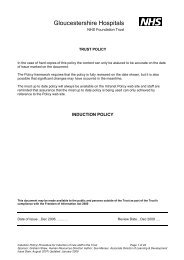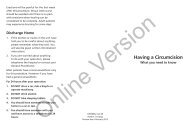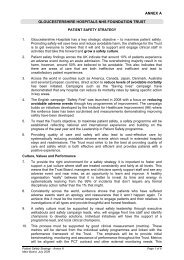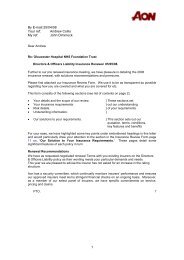What is Bath “PUVA” Therapy?
What is Bath “PUVA” Therapy?
What is Bath “PUVA” Therapy?
Create successful ePaper yourself
Turn your PDF publications into a flip-book with our unique Google optimized e-Paper software.
GHPI0749_05_07<br />
Author: Eileen Carlill<br />
Review due: May 2010<br />
Patient Information for the<br />
Gloucestershire Health Community<br />
<strong>Bath</strong> PUVA<br />
online version
online version
6) Use the d<strong>is</strong>posable wipe provided to frequently swab, with bath<br />
water, any other areas which need treatment but are not covered<br />
with bath water, e.g. shoulders and upper chest. These areas must<br />
be the same each time.<br />
7) When time <strong>is</strong> up, pull the plug out of bath and pat yourself dry<br />
with the towel provided.<br />
8) Put on a dressing gown and the blue “slippers” and go<br />
immediately to PUVA treatment room.<br />
<strong>What</strong> else should you know?<br />
1) If you have any lesions or areas of skin that you w<strong>is</strong>h to show the<br />
clinic staff please do so before having your psoralen bath.<br />
2) We recommend that you use a bland mo<strong>is</strong>tur<strong>is</strong>er (such as<br />
Diprobase) whilst you are undergoing PUVA therapy to combat<br />
the possible drying effect of the treatment.<br />
3) There are self-help groups for some of the conditions we treat<br />
- please ask for details.<br />
4) ALWAYS KEEP ALL DRUGS OUT OF THE REACH OF CHILDREN.<br />
5) If you m<strong>is</strong>s appointments, we will assume that you no longer<br />
require PUVA therapy.<br />
We must adv<strong>is</strong>e you that only persons having UV treatment are<br />
allowed to remain in the unit during treatment. Adults (unless the<br />
patient requires a carer) and ESPECIALLY CHILDREN are not allowed to<br />
wait in the treatment areas.<br />
IF YOU CANNOT ATTEND, OR YOU WOULD LIKE TO DISCUSS ANY<br />
ASPECT OF YOUR TREATMENT, YOUR CLINIC PHONE NUMBER IS:<br />
08454 228349<br />
(24 hr answerphone)<br />
4<br />
Introduction<br />
PUVA Psoralen <strong>is</strong> phototoxic (that <strong>is</strong>, it makes skin much more sensitive<br />
to light) - ask for help immediately if spilled on skin.<br />
These notes are intended to provide you with information about your<br />
treatment. Please read the whole pamphlet so that you are fully aware<br />
of how to help us make your treatment as safe and effective as we<br />
can. Any additional questions that you may have can be answered by<br />
clinic staff or doctor.<br />
<strong>What</strong> <strong>is</strong> <strong>Bath</strong> <strong>“PUVA”</strong> <strong>Therapy</strong>?<br />
<strong>Bath</strong> PUVA involves soaking for 15 minutes in a bath of water<br />
containing the drug Psoralen which, after absorption, <strong>is</strong> ‘activated’ by<br />
UVA light given in a strictly monitored dose. Several different skin<br />
d<strong>is</strong>eases can be treated effectively with PUVA.<br />
<strong>What</strong> <strong>is</strong> the UVA Light?<br />
Light <strong>is</strong> classified into many different wavelengths or parts. One<br />
part <strong>is</strong> known as ultraviolet light, a normal component of sunlight.<br />
Artificial light sources are available that produce ultraviolet “A”.<br />
<strong>What</strong> should you do before PUVA <strong>Therapy</strong>?<br />
Certain other medicines can make you more sensitive to the PUVA<br />
treatment. In addition, some medical conditions can be aggravated by<br />
PUVA. Before starting therapy, be sure to tell clinic staff, if any of the<br />
following apply to you:-<br />
1) have had a severe reaction to puvasoralen in the past,<br />
online version<br />
2) have had recent radiotherapy treatment or are planning any,<br />
3) have, or ever had, skin cancer,<br />
4) have any medical condition that requires you to stay out of the<br />
sun.<br />
5) are using any topical creams or ointments or are taking ANY<br />
medicines (th<strong>is</strong> includes items prescribed or bought over the<br />
1
counter and herbal/natural preparations such as St. John’s Wort).<br />
We are happy to check that they are suitable to use in conjunction<br />
with your PUVA treatment. Please note that any new medicines<br />
that you take during your course of treatment must always be<br />
reported to the Phototherapy staff.<br />
Please do not use any ointments or creams, coal-tar products or<br />
perfumed soaps and toiletries on the day of treatment unless<br />
specifically asked to by the staff. (Do not use Coal-Tar preparations<br />
for at least 24 hours prior to PUVA). Th<strong>is</strong> <strong>is</strong> because some perfumes<br />
and medicines contain chemicals which increase light sensitivity,<br />
and might lead to a “sunburn effect” following PUVA treatment.<br />
Once you have had your treatment you can usually then apply your<br />
ointments or creams.<br />
Hospital Policy requires you to sign a consent form for th<strong>is</strong> treatment.<br />
<strong>What</strong> special precautions should you take?<br />
1) Skin and Lip protection - Do not expose skin to sunlight or sun<br />
lamps for 24 hours after treatment. Cover as much of your skin<br />
as possible with clothing (dark, closely woven fabrics are best).<br />
Avoid sitting near a window as UV-A can pass through glass. You<br />
may be more sensitive to sunlight for 2 - 3 days.<br />
2) Apply a sunblock/high SPF suncream to sun-exposed skin before<br />
leaving the Phototherapy Department e.g. face and hands.<br />
How long will the treatment last?<br />
Th<strong>is</strong> course will last 8 weeks. It may take several weeks before your<br />
skin condition improves. Please remember that it <strong>is</strong> important to<br />
attend regularly, i.e twice a week for 8 weeks.<br />
2<br />
Are there problems associated with pregnancy<br />
or breast-feeding whilst having PUVA therapy?<br />
1) Birth-control methods should be used because the effects of<br />
PUVA therapy on the unborn child are not known. If you become<br />
pregnant, inform clinic staff immediately.<br />
2) Since it <strong>is</strong> not known whether Puvasoralen passes into mother’s<br />
milk, it <strong>is</strong> safer not to breast-feed whilst using th<strong>is</strong> drug.<br />
<strong>What</strong> are the possible side- effects?<br />
You may experience slight reddening and/or itchiness of the skin<br />
during the two or three days following treatment. More rarely<br />
tenderness or bl<strong>is</strong>tering of the skin can occur, but can be helped by<br />
products recommended by clinical staff, your doctor or pharmac<strong>is</strong>t. It <strong>is</strong><br />
important to contact your Phototherapy Dept or GP, if any side effect<br />
<strong>is</strong> severe or bothers you at any stage..<br />
Are there any long term side effects?<br />
As with prolonged sun exposure there are potential consequences for<br />
the skin from PUVA. Premature ageing of the skin including some<br />
loss of elasticity may occur. For some patients there may be a slightly<br />
increased r<strong>is</strong>k of developing one of the skin cancers (non-melanoma).<br />
However we keep the number of treatments as low as possible to<br />
minim<strong>is</strong>e th<strong>is</strong> r<strong>is</strong>k.<br />
Instructions for <strong>Bath</strong>ing<br />
1) Undress completely<br />
online version<br />
2) Put on goggles/approved eye protection (keep these on until out<br />
of bath)<br />
3) Lower yourself gently into prepared bath. Agitate the water<br />
gently from time to time but avoid splashing water over sides if<br />
possible (the bath will be quite full)<br />
4) Start the timer (15 minutes)<br />
5) Make sure your knees, shoulders etc. are submerged.<br />
3

















